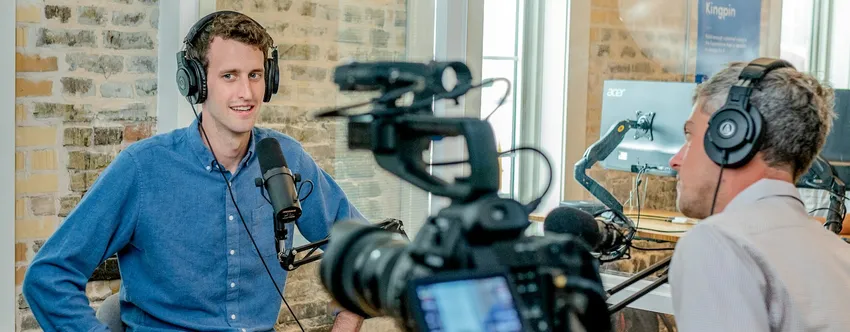Mar 25, 2025
Social Media for Podcasts: How to Build and Engage Your Audience

Podcasts have become part of everyday routines, offering stories and insights with just a tap. But with so many choices out there, finding the right show can feel overwhelming. Learn more about how to promote a podcast with comprehensive strategies. Social media steps in as a bridge that helps connect hosts with listeners in a personal way. It’s not only a place to post your latest episode link, but also a space where communities flourish through genuine interaction. Podcasters often turn to tools like Podpacer for an easier way to manage these online connections and stay organized.
A well-planned social media approach can shape how listeners see a podcast. Learn more about podcast marketing tips for effective strategies. Instead of simply dropping show links, sharing behind-the-scenes peeks or interesting questions can pull folks in and inspire them to stick around. When used in a thoughtful way, social platforms become a friendly place for listeners to gather and discuss. This sense of belonging often leads to stronger loyalty, real-time feedback, and fresh ideas from your audience.
Understanding the Importance of Social Media for Podcasts
Sharing a podcast on social media can make a real difference for any host who wants to grab attention in a busy online world. Listeners usually look for a meaningful connection with the voice they hear every week, and these interactive channels open that door. From direct messages to fun polls, social platforms let people discover and explore shows in a casual way that feels personal.
Many folks tune in to podcasts because they crave a comfortable, friendly atmosphere. Social media extends that feeling by letting audiences speak their minds and share ideas. It sets the stage for Q&A segments, behind-the-scenes posts, or fun challenges that keep discussions alive. Every time someone likes a post or drops a comment, it adds another link in the chain between podcasters and listeners.
This sense of connection has the power to spark fresh interest. One lively conversation thread can encourage a curious newcomer to press play and become a fan. Podcasters often find that posting about current events, hot topics, or audience favorites draws eyes to their show. Social platforms act like mini stages where each new post can greet fresh ears.
- Inviting listener feedback shows that you truly value their thoughts.
- Offering little extras, like behind-the-scenes tidbits, helps build genuine bonds.
- Urging followers to tag friends can push your content in front of new groups.
When the themes in a podcast match social media updates, it strengthens trust. People love consistency in style, format, and content. That steady approach encourages more shares and word-of-mouth growth. Keeping an eye on how people interact—like noting which posts get the most likes or comments—makes it easier to see what works best. Starting conversations about show topics also appeals to potential listeners who enjoy friendly exchanges.
One practical idea is to post open-ended questions that invite anyone to jump in. This signals that everyone’s voice is welcome. Folks appreciate feeling seen, and a simple reply can make them stick around for the long haul. The best part is, the more you engage in these conversations, the wider your show’s net becomes. Social media is a partner that helps your podcast shine, which is why many see it as a vital tool in building a loyal community.
Choosing the Right Platforms for Your Podcast
Selecting the right social channels can influence how new listeners find a podcast. Every platform attracts different age groups and interests, so matching your show’s style to a site’s audience can help you reach people who are actually looking for your kind of content. It’s smart to pin down your main demographic and then figure out which networks support that focus. This approach prevents wasted effort on platforms that don’t connect well with your show’s message.
Each network offers a distinct user experience. Some folks love spaces designed for in-depth chats, while others really enjoy quick reels or snappy updates. Adapting your posting habits to fit those preferences can yield stronger engagement. A thoughtful plan can also protect you from burnout by showing you exactly where your time and effort have the most impact.
Starting with one or two platforms is often less stressful. By narrowing your scope, you’ll be able to respond swiftly to comments, gather real feedback, and learn which types of posts catch your audience’s eye. Once you see results on a small scale, you can gradually branch out if that feels right. Expanding carefully increases the odds of maintaining the same quality and warmth across all channels.
Here are a few steps to consider:
- Look into the ages, interests, and behaviors of users on each platform.
- Match your show’s style to the platform’s strong points, whether it’s video, images, or text.
- Try posting at various times and check when your engagement goes up.
- Keep tabs on popular posts to see what sparks conversations.
Going all-in on many sites at once can sap your focus. A consistent presence where your audience already hangs out often prompts them to share your content with friends. Keeping a steady tone, style, and posting timetable makes your voice recognizable. Over time, this familiarity can encourage loyal followers who support your show’s growth in a sustainable way.
1. Facebook: Connecting with a Mature Audience
Facebook often appeals to individuals in their mid-30s and beyond. Learn more about boosting podcast engagement with controversial topics to increase listener interest. They tend to appreciate longer conversations and posts that encourage reflection on topics discussed in your show. Groups on this platform can function like cozy gatherings, where dedicated listeners meet and share stories related to your episodes. A private group even creates a sense of exclusivity that rewards loyal fans.
It can be helpful to post questions that spark thoughtful discussions about what was featured in an episode. Polls are another way to invite people to weigh in, which adds a sense of belonging. A group also allows members to offer suggestions for future topics, making them feel like key contributors to the podcast’s direction. That feeling of involvement can inspire more frequent listening.
2. Instagram: Visual Storytelling and Engagement
Instagram thrives on photos and short clips. Learn more about how to write perfect podcast script to create compelling content. Sharing behind-the-scenes snapshots or eye-catching quotes from your latest episode can give folks a quick taste of your content. Reels with fun transitions or highlights from conversations are great for hooking casual scrollers. With consistent visuals and captions that prompt comments, you can cultivate a sense of familiarity that invites new fans to browse your profile and click on podcast links.
3. TikTok: Reaching Younger Listeners with Viral Content
TikTok is known for brief, creative videos that can spread fast. Learn more about podcast production workflow to streamline your process. Show off highlights from your episodes by adding a playful twist or a useful tip. It’s a solid fit for hosts who want to connect with teens or young adults who enjoy quick nuggets of entertainment. By hopping on popular trends or creating your own, you can spark curiosity and get people to check out your full-length podcast.
4. LinkedIn: Networking and Professional Growth
LinkedIn caters to professionals who want content that boosts their skills or knowledge. Learn more about essential questions for podcast interviews to make your guest appearances more engaging. Sharing data-backed insights, expert interviews, or tips from business-minded episodes can appeal to this crowd. It’s also a good spot to show off your expertise or network with leaders in your field. Focusing on actionable advice and clear language tends to attract people who are serious about career growth.
5. Twitter (or X): Real-Time Interaction and Updates
Twitter is fast-paced and thrives on quick updates, short chats, and hashtags. A simple question about your new episode can trigger replies or retweets, bringing fresh eyes to your show. Hashtags help keep the conversation organized so that potential listeners can easily find your content. This is a space where real-time chats can offer immediate feedback, giving you a glimpse into how folks feel about your latest uploads.
Content Strategies for Social Media Success
Posting on a whim isn’t always the best way to grow a show. A clear plan helps your content stand out and builds interest in what’s coming next. Online feeds can feel chaotic, so it pays to think about what you want your posts to do—whether that’s spark conversation or highlight an upcoming guest. Sharing at a steady pace keeps fans engaged and excited about future episodes.
A huge part of planning involves knowing your audience’s habits and interests. Some folks are early risers who scroll soon after they wake up, while others jump online in the evening. Timing your posts around these patterns can lead to better visibility. And keep in mind that strong images or short videos often grab more attention than plain text. Mixing up post formats can reach different types of users.
- Use calls to action: Ask a question that encourages people to react.
- Change things up: Try text, images, and even quick audio clips.
- Make interactive features your friend: Polls, quizzes, or stories let followers jump in.
- Suggest tagging a friend who might enjoy the show: People love sharing content that feels relevant.
Staying consistent with style, tone, and posting rhythm shows that you’re reliable. It can help to align your social schedule with each new episode. Maybe tease what’s coming a few days before launch, announce the release, then follow up with a highlights post. Keep an eye on comments, shares, and likes for clues about what resonates.
Podcasters often use resources like Podpacer to make repurposing clips or scheduling posts simpler, freeing up time to chat with listeners in real moments. That extra focus on engagement can yield stronger connections than simply barraging people with random links. Sometimes a friendly word or a quick reply in the comments can leave a lasting impression. Being approachable helps your community feel valued, which is a big reason they’ll keep coming back for more.
1. Creating Engaging Content that Resonates
Stories packed with emotion tend to draw the most attention. A short funny story from a guest, or a heartfelt quote that sums up a tough topic, can hook viewers faster than plain text. Showing warmth behind the mic also invites listeners to see the host as a real person.
2. Utilizing Audiograms and Video Snippets
An audiogram highlights a few seconds of your podcast audio with on-screen text or a moving waveform. Learn more about best audio editing software for podcasters to enhance your content. This can catch the eye in a sea of scrolling posts, especially on platforms that prioritize visuals. Short video clips of fun or dramatic moments can spark enough curiosity that viewers decide to click over and hear the entire episode. It’s all about giving a quick taste of what’s waiting in the full show.
3. Leveraging Influencer Collaborations
Teaming up with well-known figures in your niche can widen your reach. Giving them a snippet or visual to share on their own pages can draw their followers in. These crossover moments create a chance to grow your audience quickly. Once folks sample your podcast, they might stick around if they like what they hear.
Building a Community Around Your Podcast
Humans love being part of a group, and that’s often what draws people to podcasts in the first place. There’s a unique bond that forms when listeners realize others share their interests, frustrations, or joys. Social media can extend that feeling by giving them a space to gather, chat, and form real friendships tied to your show’s themes. After hearing an episode, many individuals enjoy sharing their reactions in the comments or messaging the host directly.
Posting real-life glimpses of your recording space or your personal take on a talking point can inspire your audience to open up. They may share their own experiences, ask follow-up questions, or suggest new ideas for future episodes. Each comment or direct message is a chance to deepen relationships and remind folks that their voices matter. When folks feel heard, they’re more likely to keep tuning in and even pass the show along to their friends.
It’s often helpful to notice which types of posts get people chatting the most. An unexpected poll or relatable meme might spark a bigger conversation than a standard promo post. Encouraging these discussions shows that you value every listener’s opinion. Over time, you’ll see trends that can shape your future topics or guests. Audiences can guide you toward the subjects they care about most, making your show feel more relevant to them.
- Set up a group or forum for open discussions, like a Facebook group.
- Invite listeners to submit audio clips that you can feature in an upcoming episode.
- Offer small perks, such as bonus clips or transcripts, to folks who regularly comment or share.
Having a lively group is better than having a giant, silent one. A tight-knit circle is far more likely to boost your podcast by telling friends and posting about it on their own pages. Listening to feedback, praising user-generated content, or running fun contests can breathe life into your social spaces. Those personal touches let listeners know that you see them and value their time. Over time, these bonds can do more for your podcast’s growth than any other strategy.
Encouraging Listener Interaction and Feedback
Asking specific questions or inviting opinions can help quieter followers speak up. If there’s a tricky topic in your show, pose a friendly challenge for listeners to share their insights. This kind of open dialog often results in new ideas or even corrections you wouldn’t have thought of alone.
Hosting Live Sessions and Q&A Events
Scheduling live streams is a direct way to meet your audience. Plenty of people enjoy seeing the face behind the mic or asking questions on the spot. Giving a little notice so people can plan to attend usually boosts turnout. When you interact in real time, the energy becomes more vibrant, and folks appreciate the personal touch.
Promoting User-Generated Content
Inviting fans to submit art, photos, or personal stories adds a sense of co-creation. Featuring these items in your feed can make listeners feel like they’re truly part of the podcast’s story. They might even show their friends that their work got a shout-out, inspiring more shares and new listeners.
Measuring Success and Optimizing Your Approach
Taking a closer look at how people react to your posts can reveal what resonates most. It’s not all about large follower counts. An engaged community that comments and shares is often more valuable than a higher number of silent followers. Metrics like likes, shares, or the length of comment threads can show where your show’s sweet spot might be. Every piece of data tells a story, and it’s wise to let those stories guide you.
Real feedback, such as direct messages or comments, can point to what your listeners really want. You might find that a quick, humorous video does best in the morning, while a more in-depth caption gets read at night. Adapting your posting schedule or style based on this info can keep you in step with your audience. Trying out different post lengths, topics, or formats is part of a natural trial-and-error process that helps refine your approach.
- Track how various formats (video, audio clips, text) perform to see what sparks curiosity.
- Keep an eye on link clicks for each episode promo to see where people jump over to your show.
- Compare your engagement rate with similar podcasts to get a sense of how you’re doing.
Throwing something new at your listeners can feel risky, but sticking to the same routine forever may lead to boredom. When a post falls flat, view it as a clue that it might be time to try a fresh angle. Even small tweaks in tone, visuals, or call-to-action statements may make a difference. Keeping an open mind makes it easier to pivot toward whatever approach brings the best outcomes.
This ongoing experiment can be exciting if you see it as a chance to learn. With each month’s data, you can celebrate small gains and lean into strategies that are clearly working. That way, growth doesn’t feel random. It feels guided by real insight into what makes your unique audience click and comment.
Analyzing Social Media Metrics and Feedback
Keywords in comments often highlight common interests. If you notice people asking the same questions or sharing the same concerns, those might become hot topics for future episodes. This approach makes them feel heard and keeps them coming back for extra insights.
Adapting Strategies Based on Audience Insights
Every show has a unique crowd, so one-size-fits-all tactics may not always work. If you see that polls do well on one platform but not another, lean into what’s already clicking. That kind of flexibility can keep your podcast fresh while ensuring you’re giving fans what they actually want.
Conclusion: Maximize Your Podcast’s Reach with Social Media
Focusing on the best platforms, posting eye-catching material, and building real connections can boost your podcast in a big way. Each social channel has its own flavor, and fine-tuning your approach based on listener feedback is worth the effort. Many podcasters rely on a service like Podpacer to streamline content tasks, which leaves more room for actual conversations with fans.
Audience feedback often shows the path forward. Checking comments, mentions, or messages can help you spot areas that need attention or topics that users love. When you post regularly and answer questions, people pick up on your genuine interest in their stories. This spark of human connection can push them to share your show with friends.
Staying clear on your goals and watching your metrics will guide your choices as your show grows. A strong online presence can foster trust, encourage shares, and turn casual listeners into devoted supporters. By treating social media as a friendly bridge, you can bring your audience closer and keep your podcast’s momentum going.
Frequently Asked Questions (FAQ):
What social media platform is best for podcasts?
The best social media channel often depends on the listeners you want to reach. Sites like Instagram, TikTok, or YouTube work well because they’re visual and promote shareable elements that can give your podcast extra exposure.
How do I promote my podcast on social media?
To spread the word, create clips or highlight reels of your episodes, use relevant hashtags, team up with influencers, and chat with your followers. Giving people interesting content and actively engaging encourages them to pass it on to their own networks.
How do I get 1000 listeners for my podcast?
Reaching that milestone often comes down to picking a clear niche, delivering valuable episodes, boosting awareness on social channels, collaborating with other podcasters, and asking your listeners to share. Learn more about how to grow your podcast audience naturally for detailed tips. It helps to be consistent and keep improving with each release.
What platform do most people listen to podcasts?
Most folks listen on apps like Spotify, Apple Podcasts, or Google Podcasts, known for their user-friendly design and easy availability across phones and other devices.
Related Posts
See All Posts

Social Media for Podcasts: How to Build and Engage Your Audience
Podcasts have become part of everyday routines, offering stories and insights with just a tap. But with so many choices out there, finding t


Mastering Podcast SEO Techniques: A Comprehensive Guide
In a world where podcasts keep growing, getting noticed can feel like a climb. There's a bright side, though. [Learn more about boost podcas


Top Podcast Promotion Strategies for 2025
Plenty of podcast creators hope to stand out in a sea of audio content. With over two million shows available, it's essential to find new wa
No one knows your podcast like Podpacer
Podpacer is the best way to handle your podcast production. Manage your guests, research and plan your interviews, write social media content with one click, all in one place.


